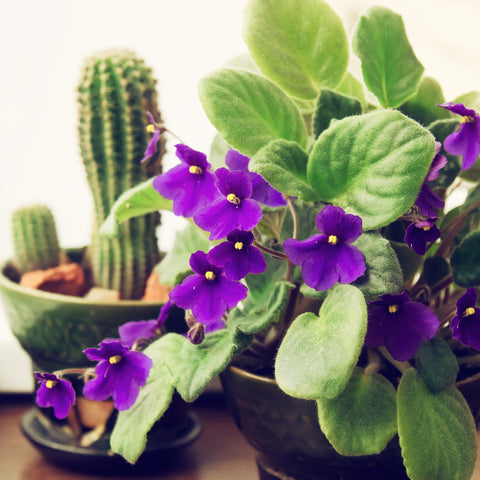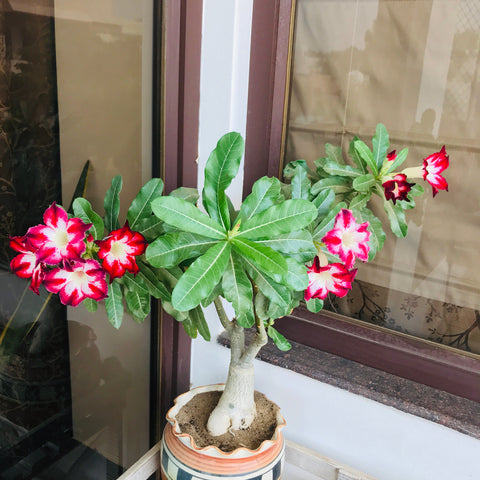Exotic house plants can be a great way to make your home stand out. They bring color, flair and uniqueness to your home even if you live in colder climates. While some exotic houseplants are known for their vibrant colors, others are known for their large, unusually patterned or variegated leaves.
We've compiled a list of 21 of some of the most exotic houseplants that you should definitely consider bringing into your home for some new decor!
Aeonium (Black rose, Irish Rose, Sunburst, rose succulent, Kiwi Aeonium)- Aeoniums are a wild and whimsical group of succulents from the subtropical Canary Islands. In order to develop its full bright colorful potential, they need at least 6 hours of full sun a day.
Haworthia(Window Haworthia, Zebra Plant, African Pearls)- In their native environment, haworthias are usually found in the shade of a rock or other object. But as indoor plants, they do best in a room with a window facing east or west to provide bright light a few hours a day. 
Geraniums- These sun-loving plants require 4-6 hours a direct sunlight a day. South and west facing windows have the best lighting for these beautiful plants to bloom. They can also do well with more sunlight time in an area with filtered lighting. 
Monstera (Monstera Deliciosa, Little Swiss cheese Monstera)-One of the most common indoor houseplant is the monstera deliciosa, which originated in tropical regions such as Central America ranging from southern most part of Mexico to Panama. They are noted for the big bold leaves that almost look like swiss cheese. Their ability to thrive in shade makes them well-suited to living indoors. 
Dwarf Umbrella Tree- Umbrella plants require little sunlight but should never be positioned in direct sunlight. So, a window with minor shading, and a spot of indirect sunlight is ideal for these babies to flourish. Too much direct sunlight will cause the leaves to burn. 
Pony Tail Palm- These beauties need plenty of bright light near the window, but not in direct sunlight! Make sure there is some shaded area near your window. 
Hibiscus- This gorgeous flower does best in full sun! The rule of thumb is to give it 6 hours of sun each day in order for it to bloom to its fullest potential. There is such a thing as too much light so be wary of the time it spends in the sun.

Aloe(Lace Aloe, Short Leaf Aloe, Aloe Vera)- Aloe vera is made up 99.5% of water, but the .5% of the solid portions are known to carry the most active nutrients. Thrives best in hot dry climate, making it perfect for direct sunlight.

Jade Plant (Sunset Jade, Silver Jade, Skinny Fingers Jade, Lemon and Lime, Necklace Jade)-These babies need at least four hours of sunlight each day, so a south-facing window would definitely be ideal. They can grow anywhere from 4-inch little plants to 4-foot trees. 
Croton (Petra Croton, Banana Croton, Gold Dust Croton, Mammy Croton) Croton plants prefer full sun, but depending on the species, some can tolerate partial shade. Crotons are colorful plants; more sunlight will definitely help bring out full vibrant colors. 
Snake Plant(Black gold, Birds Nest,Twisted Sister, Futura Robusta)- An ideal spot for this plant is about 10 feet away from a west or south window. They definitely grow more quickly in brighter light but be careful not to leave it in strong direct sunlight, as the leaves will burn and wilt. 
Peperomia(Rainbow Peperomia, Watermelon Peperomia, Belly Button Peperomia, Raindrop Peperomia)- Although there are more than 1500 species of the Peperomia plant, we have listed the most common indoor houseplant variety. It is native to all tropical and subtropical regions of the world, mostly concentrated in Central America and northern South America.

Arrowhead Plant- Arrowhead plant gets its name from having leaves that resemble arrow points. These plants are native to South America and they frequently grow in shallow lakes, ponds and streams but have become common houseplants. 
Prayer Plant- Also known as praying hands, is a flowering plant of the family maranteceae, native to the New World tropics. It has spreading leaves that turn upward toward evening, seemingly in prayer for evening vespers. 
Waffle Plant- The colorful purple Waffle Plant produces rich purple-tinted foliage with a crinkly look, resembling the texture of a waffle. It is native to Asia, and are most commonly used as a hanging plant or on the patio. 
Rubber Plant- Another common indoor plant, this plant is a member of the Moraceae family and is native to parts of Asia, particularly India, Malaysia, and Java. In the wild, it can grow to a sizeable tree with many aerial roots but can adapt to be a decent size indoor plant when taken care of properly. 
Dragon Tree- This subtropical tree plant is native to the Canary Islands, Cape Verde, Madeira, and western Morocco. It is commonly cultivated as an ornament plant. 
Moth Orchid- A native to southeastern Asia and parts of Australia, the moth orchid comes in different vibrant colors. The lightly sweet smell of the orchid is most distinct at sunrise. 
African Violets- This perennial flowering plant is native to Tanzania adjacent southeastern Kenya in eastern tropical Africa. As abundant as they are as cultivated plants, several of the native species are considered threatened or endangered due to deforestation. 
Kalanchoe (Red Pancakes, Paddle Plant, Mother of Thousands, Panda Plant)- Be sure to have some shade around your window sill because even though these plants prefer natural sunlight, too much light can burn their leaves. They will grow and thrive in the perfect amount of lighting. 
Desert rose- These beauties like bright light so a southern window exposure gives enough sun for the plants to flourish and bloom. The vibrant colors will also brighten up that window area. 


